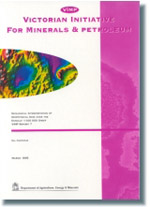VIMP Report 7 - A geological interpretation of geophysical data over the Dunolly 1:100 000 sheet
 |
| |||||||||||||||
Product description:Download The downloadable version of this report is supplied in PDF format. Abstract Detailed airborne magnetic and radiometric data and semi regional gravity data over the Dunolly 1:100 000 sheet on the St Arnaud 1:250 000 mapsheet have been interpreted as part of the Lachlan Fold Belt project under the National Geoscience Mapping Accord. The dominant lithologies found on the Dunolly 1:100 000 sheet and interpreted in the geophysical data are sediments, granites and Newer Volcanics. The sediments have been subdivided into three zones based on the strike direction of the sediments and the proportion of magnetic units compared with non magnetic units contained within the zone. Magnetic susceptibility measurements indicate that shales and slates are sometimes weakly magnetic and sometimes non magnetic, while sandstones are rarely magnetic. Some of the magnetic units may be of volcanic origin. Four large intrusions and a number of smaller ones have been interpreted. Magnetic data indicate zoning within the granites suggesting multiple phases of intrusion. The Newer Volcanics are characterised by high frequency anomalies. Both positively and negatively magnetized flows are found on the Dunolly 1:100 000 sheet, suggesting at least two episodes of volcanic activity. Within the sediments a number of pairs of magnetic units occur close together which have been interpreted to represent the two limbs of a tightly folded unit. Faulting in northwest and northeast directions is common with faults passing through both the sediments and the granites. The geophysical data are useful for identifying prospective zones and targets for alluvial and bedrock mineralisation. From radiometric and magnetic data deep leads and Tertiary gravels have been identified which may contain gold or heavy minerals. CRAE successfully used detailed gravity traverses on the Dunolly 1:100 000 sheet to locate deep leads. There are many groups of quartz reefs and workings which correlate with stratigraphic units interpreted from the magnetic data. Bibliographic reference Whitehead, M.L., 1995. Geological interpetation of geophysical data over the Dunolly 1:100 000 sheet. Geological Survey of Victoria VIMP Report 7. Department of Agriculture, Energy and Minerals. Related products:
| ||||||||||||||||


